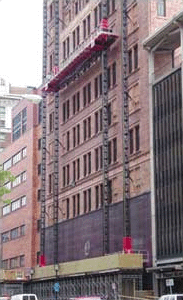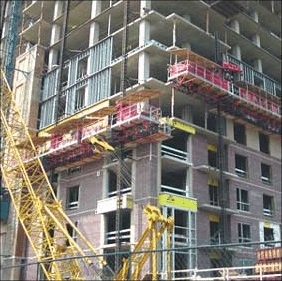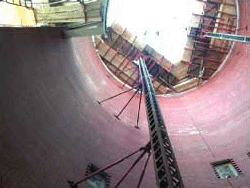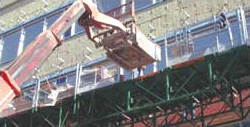Climbing Without Falling
By Tom Inglesby
 At almost every height, work platforms offer more safety than transitional pipe and brace scaffolding, but require more care and caution on the part of the erectors and users.
At almost every height, work platforms offer more safety than transitional pipe and brace scaffolding, but require more care and caution on the part of the erectors and users.
The most common work platform for masonry is the pipe, brace and plank scaffold that can be traced, in form at least, to ancient Egypt. More recently, crank-up or motorized mast climbing scaffolding has become a common sight on job sites around the world. This is especially true when the work height is over 30 feet and the span of work is in the hundreds of feet. As one ad says, "From 21 to 2100 [linear] feet" the work platform is king.
Although safety should always be at the forefront, there are three times when special care must be taken in the field for safe operation of mechanical and motorized work platforms: erection, use and disassembly. While details are different with different units, there are some common areas to be concerned with and there should be an overall desire to go beyond the OSHA requirements for safety.
OSHA regulates the safe operation of scaffolding with a variety of rules and regulations. The most basic rule is to provide, at each job site, a "competent person" who has training, experience and the ability to halt unsafe operations. That last factor is important because, without that ability, work might continue in an unsafe manner while waiting for repair parts or service to be completed.
The competent person is often the supervisor or foreman on the job, someone who would normally have that authority and who has been trained to see and understand the issues of safety in regard to work platforms. But foremen and supervisors are not usually on the platform with the workers and can often be found in the trailer or office during the work. That's why there should also be one or more workers designated as a "qualified person."
A qualified person is someone who can identify the hazards and fix them. "As an example, a qualified person might be a laborer, or half a dozen laborers who are working on the platform who understand the equipment and understand the hazards but they don't have the ability or authority to stop work," comments Chad Baumgartner, co-founder of Hydro Mobile Inc., L'Assomption, Quebec. "By definition I think they have done themselves some good by not only coming up with the term of 'competent person,' but also 'qualified person.' There's a difference there. They understand they need competent and qualified persons on the platform."
Mast Climber U.
 So, how does a worker become a qualified person in regard to mast climbers? Through proper training. As Baumgartner says, "One of the problems we have had in using any type of scaffold is that if we had five people that were responsible for setting up the scaffold, not one of them did it the same as any of the others. If one person did it this way, another person did it that way; but when they're working on the same job, inevitably something didn't get done every time. What we've done is created a school, Hydro Mobile University, where for every machine that a contractor buys, they also get a seat in the school; if they buy ten machines, they are allowed ten seats in the University. They are responsible to pay transportation to the factory. From there we pick up all the expenses, hotel, meals, etc., for a three-day boot camp. It's an intense instructional, safety-oriented course on how to use the equipment, not only safely, but productively as well."
So, how does a worker become a qualified person in regard to mast climbers? Through proper training. As Baumgartner says, "One of the problems we have had in using any type of scaffold is that if we had five people that were responsible for setting up the scaffold, not one of them did it the same as any of the others. If one person did it this way, another person did it that way; but when they're working on the same job, inevitably something didn't get done every time. What we've done is created a school, Hydro Mobile University, where for every machine that a contractor buys, they also get a seat in the school; if they buy ten machines, they are allowed ten seats in the University. They are responsible to pay transportation to the factory. From there we pick up all the expenses, hotel, meals, etc., for a three-day boot camp. It's an intense instructional, safety-oriented course on how to use the equipment, not only safely, but productively as well."
He continues, "We want to make sure that they have at least used the equipment at one job prior to coming to the University so we do field training first of all. We have people who do the on-site training to get the first job under the worker's belt. That field training, along with the operator's manual and a video we produced, gets them started right. Then when they come to the Hydro Mobile University, we reinforce everything we've taught them in the field and, at the same time, we teach them the tricks that are correct."
Correct tricks? "There are some tricks people have developed that you wish they never did," says Baumgartner. "We'll tell them the tricks that are acceptable. We've tried to keep everybody on the same page by drawing black and white lines. If someone wants to deviate from those black and white lines, they need to discuss it with our engineering department. As an example, we have a maximum of a 56-foot bridge between two motorized units but we've made bridges as long as 86 feet. When we do allow that, we want to know who the contractor is, what the conditions are, and if there is any other way to do it. If there isn't, we'll get a set of blueprints from that project sent to engineering and engineering will give them a specific layout for that particular job. They'll stamp it, sign it and they'll be able to use a longer bridge or cantilever for that particular job based on engineering and, perhaps, based on new capacities."
Yannick St. Pierre of Fraco, Saint-Mathias-sur-Richelieu, Quebec, agrees that training, on the job site and in the company's facilities, makes the use of mast climbers safer. At Fraco, they break training down into different levels based on the work being done. "Our Level One training it not for the installation, it's for the safe use of the platform, and how to load and operate it correctly with all of the safety recommendations ? it is based on the OSHA training program. We have a Level Two training for installing, dismantling and moving the platform. There's a Level Three that is the maintenance of the platform. We insist on safety and every person who's going to use the platform receives the proper training."
He adds, "If we do the installation for the customer, we will train a group of workers on the job site to use and perform all the inspection of the platform, to have it work properly and safely. When we do the installation, dismantling and moving, we will train one worker in each level at the job site. If it is necessary, we also do training class here at the office or in one of our branches. When we do a Level Three, which is the proper maintenance of the equipment, then we bring the workers into our plant and have them follow all the assembling and maintenance of the equipment. We have training videos for each of our models that cover standard applications, standard installation free standing, and then with wall ties on the building."
The emphasis on training isn't just to prevent accidents. A properly trained worker tends to be more productive as well. St. Pierre says, "Before pushing people to increase their productivity and to maximize their work, the first thing management must understand is safety."
One way to improve productivity ? and safety ? was to design the work platform for safety from the start. For example, Baumgartner says, "One of the things that's most obvious is trying to create a safe and comfortable work atmosphere. By creating an atmosphere where everyone is comfortable, they become more productive. Ten years ago the platforms had an expanded metal deck. The expanded metal was a lot lighter and made the equipment easier to handle, but someone working 100 feet up in the air would watch every footstep because he could see the ground.
"Now we use a stamped, steel deck ? a solid deck that's seven feet wide. By putting that stamped steel deck up there, they are very comfortable. They are completely guard-railed from the moment they initially set up the equipment ? all of the guardrails are in-place. All of the safety features are inherent in the machine at any elevation."
Guardedly Moving
 Guardrails are standard safety protection. St. Pierre states, "When all of the guardrails are in place and the planking is well done, the safety is not an issue for the worker, even at 60 feet, because they are all very protected and the workplace is very safe. The main problem is when you remove guardrails to load the platform or when they are moving the planking, for example, passing through a balcony. During these operations, workers should wear a safety harness. The other issue is, when they use it, they must respect the loading capacity of the platform and where they have to put the material for balance."
Guardrails are standard safety protection. St. Pierre states, "When all of the guardrails are in place and the planking is well done, the safety is not an issue for the worker, even at 60 feet, because they are all very protected and the workplace is very safe. The main problem is when you remove guardrails to load the platform or when they are moving the planking, for example, passing through a balcony. During these operations, workers should wear a safety harness. The other issue is, when they use it, they must respect the loading capacity of the platform and where they have to put the material for balance."
"Scaffolding has a connotation of being dangerous equipment," says Baumgartner. "At least when you talk to an insurance company. But in reality, most scaffold accidents are due to improper usage. In the case of mast climbers, we don't use the x-braces, but there are other things that compensate for it. As an example, our M-series machine has no x-braces and it's freestanding to 35 feet, but if you go above 35 feet you need to tie it to the wall at 20 feet and then you tie in 20-foot intervals. The anchor points have a requirement of 3000 pounds tension and compression strength. If they put the anchorment into something that doesn't have that strength, they jeopardize the stability of the platform."
Using tie-backs can be deceiving. Ralph Bennett, professor of Civil Engineering Technology at Purdue University, Hammond, Ind., teaches scaffolding, among other subjects. He notes, "Think about a scaffold like this: when you have a new wall, what's supporting that new wall? The scaffold. Everyone assumes that you're tying the scaffold to the wall, but there's no strength in the wall. It's really nothing more than a 'good luck' theory. Every time you see a wall come down onto a scaffold, it just proves the point that when you have a wind, the scaffold actually held up the wall rather than the other way around."
Speaking of wind, workers in the "Windy City" ? Chicago ? often have a difficult time with any scaffolding, not just mast climbers. St. Pierre explains, "Working in New York or Chicago, there are wind currents that can build very high wind pressure on the platform. We do calculations with the specific wind force in a city and, to keep the safety factor that we have, we can modify the wall tie sequence on the mast. For example, we might get an anchor each story instead of every two stories like we do normally. We did a test with our mast section and the limit was 100,000 pounds. The mast didn't bend or collapse. The strength of the section is very high."
Coming Down from Above
 Not all work platforms climb up on masts. While not as common to masons as the ground-up scaffolding, suspended scaffolding has a definite place in the mason contractor's portfolio. When completing tuckpointing and restoration work, using a suspended scaffold can be positive to both the masons working on it and to the contractor's bottom line.
Not all work platforms climb up on masts. While not as common to masons as the ground-up scaffolding, suspended scaffolding has a definite place in the mason contractor's portfolio. When completing tuckpointing and restoration work, using a suspended scaffold can be positive to both the masons working on it and to the contractor's bottom line.
There are, however, different rules for safety on a suspended scaffold, some of which are burdens on contractors ? use of fall restraints, for example ? but add to the productivity of the workers using these platforms.
Considered one of the originators of the suspended scaffold, Sky Climber of Stone Mountain, Ga., considers safety of its users as its highest priority. John Boswell, safety director of Sky Climber emphasizes the need ? and the legal requirement ? of users to be trained on the assembly and use of these platforms. "It's one of the first things I would tell any new user: acquire the training necessary. It's an OSHA requirement that they are trained whether the employer provides them training in the safe use of the equipment or if they obtain that training from the vendor."
Vendor training is perhaps the best choice since it is readily available and, obviously, up-to-date with both the technology and the OSHA requirements. Boswell explains, "Sky Climber has a one-day safety and applications certification course. We've put about 16,000 people through it and no one who's been through our course has been in an accident involving an injury. In addition, the Scaffold Industry Association (SIA) has a correspondence course on suspended scaffolds."
There are two sections under OSHA's guidelines specific to scaffolding, including suspended scaffolding. One is CFR1910.28 and the other is CFR1926.451. The first is for general industry safety and the second is for construction-specific applications. Also, CFR 1926.21 V2 states that the employer shall instruct each employee in the recognition and avoidance of unsafe conditions, and make them aware of the regulations applicable to his or her work environment regarding the control or elimination of any hazards or other exposure to illness or injury.
Boswell says, "The first thing I caution everybody is that they should know and understand the load capacities of the equipment they're using. There is no standard for it. The capacity of the hoists, the platforms and the topside rigging devices vary. All of those are required to be labeled with their capacities. So anybody using that equipment needs to make sure those labels are there."
When the equipment is in a safe working condition, then that equates to better safety for the workers. According to Boswell, "The equipment needs to be inspected each day. The way we teach it is to do it from the topside down. The topside rigging is critical and there are a number of different temporary devices that can be used for suspending the scaffolding. The number one thing is, there must be a structurally sound parapet wall ? in almost all cases that's going to be a poured-in-place or precast, reinforced concrete wall. There are two devices used for rigging directly off of the parapet wall. One's called a cornice hook and the other is called a parapet clamp. One of the most common mistakes we see that has and can lead to accidents is rigging off of a masonry wall using one of those devices. That should never be done."
He continues, "Everything is based on the rated working load of the hoist that you're using, with a 4:1 safety factor considered minimum. For example, if you were using a thousand-pound hoist, which is not standard but very common, everything you attach up top would have to be capable of supporting 4,000 pounds. To accomplish that, if you're attaching directly to the parapet wall, you have to have some sort of verification that the wall will support that weight. Those devices should not be used on a masonry wall. Typically, the way this equipment would be rigged, if you cannot attach directly to the parapet wall, you'd be rigging directly off the roof with some sort of counterweighted, beam system. In a lot of cases, that is called a rolling roof rig ? a device that just elevates a beam so you can cantilever out beyond the wall to get your suspension point, which is then counterweighted to keep it from tipping."
Move up, not sideways
Although the rigging beam is called a rolling roof rig, it cannot be used to move the platform laterally while workers are on the scaffolding. Boswell says, "You have to bring the platform to the ground, get the load off of it, then you move your top-side rigging and wire ropes and then move the platform to the next drop. You have to take the load off, then the beam rolls to the next location. Even the more common 'window washer's' rig isn't supposed to be moving laterally.
"There are two different types of hoists used on temporary equipment," he adds. "One is a traction hoist which climbs the wire rope. Then there are drum hoists that accumulate the wire rope on a drum and climb up the wall that way. In both cases the platforms are brought to the ground, and are brought off of the ground."
Worker Personal Safety
With safe equipment, the safety of the workers still depends on two things: caution and knowledge. As Boswell notes, "The number one thing is, a personal fall arrest system is required by anybody using a suspended scaffold. We don't know of any cases where there's been a fatality with anybody that's been protected correctly by an independent fall arrest system. Even if something else fails, it's extremely important. That means a full body harness, a shock-absorbing lanyard that attaches from the harness to a rope grab, which is a self-belay device. The rope grab opens up and attaches to a vertical lifeline, which is usually a 5/8- or 3/4-inch synthetic rope that enables the workers to travel up and down the drop while maintaining a constant connection to that vertical lifeline. It locks off in case of a fall or scaffolding failure to prevent them from falling. Even if the platform fell out from under them, their harness, shock-absorbing lanyard and rope grab would catch them."
The operator keeps the rope grab at shoulder height and while operating the hoist with one hand, moves the rope grab with the other. OSHA limits the maximum amount you can fall before your fall arrest system kicks in to six feet. If the equipment works properly, the maximum free fall would be a good bit less than that.
The other personnel concern is at the top. "The anchorage at the top for that vertical lifeline has to be completely independent from anything that the scaffold is attached to," says Boswell. "If that whole scaffold system failed, your fall arrest anchorage point, under the OSHA standards, has to meet 5,000-pound strength."
About the Author
Tom Inglesby is a San Diego-based freelance writer whose work has appeared in numerous online and print publications. He is the winner of the Construction Writers Association's 2002 Boger Award for Special Reports.
Photos courtesy of Fraco and Hydro Mobile, Inc.


















